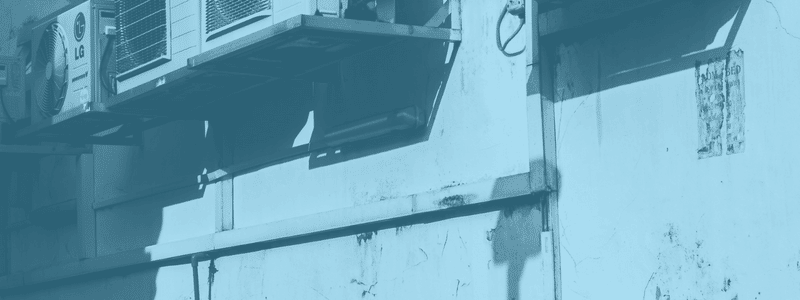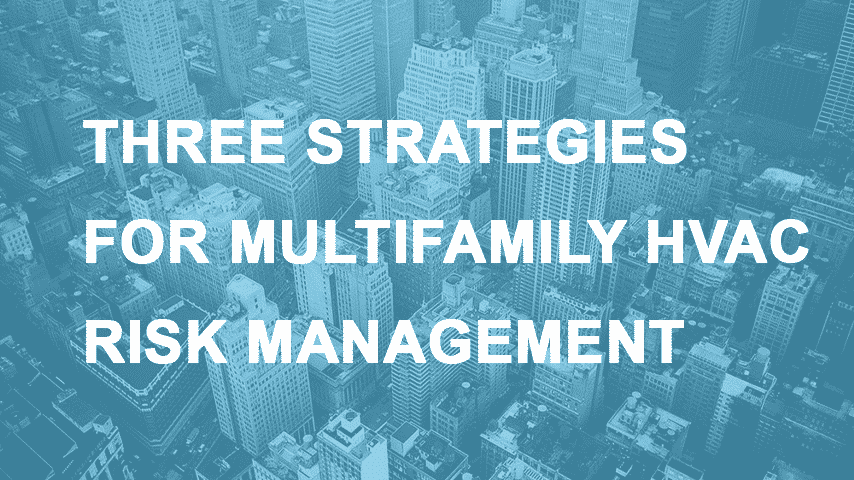A few different types of HVAC systems are suitable for apartment buildings.
Those certainly include centralized systems (hot water baseboard, two-pipe, four-pipe, and geothermal systems…). But if the building already has one, you have no choice.
Decentralized systems offer more freedom. For example, baseboard heaters and wall units are relatively cheap to install. At the same time, self-contained systems provide the best efficiency out of all decentralized units.


How Does an HVAC System Work?
HVAC units can cool and heat in various ways because of the different types of units. For example, some use a condenser for the cooling process, while others use a heat pump. But for most traditional systems, the process goes like this:
- The thermostat notices the temperature needs to be lowered and sends a signal to the air conditioning components to start running.
- The indoor unit fan pulls hot air from the house through air ducts.
- After passing through filters, the hot air passes over evaporator coils and cools as the refrigerant absorbs it.
- Then the indoor unit’s blower fan takes the newly chilled air and sends it back through the ducts, creating ideal temperatures.
On the other hand, here’s how the furnace works:
- Propane or gas generates heat in the furnace’s burner
- Then the heat passes through a heat exchanger to increase the temperature
- Air from the ductwork is blown over the heat exchanger
- Finally, the furnace’s blower sends the warm air into the ductwork to get distributed throughout the property
What Are the Different Types of HVAC Systems?
There is more than a one-size-fits-all solution for a property’s heating and cooling needs. But that’s why there are various HVAC units available such as:
- Split system: Has an indoor unit used to heat the interior, while the outdoor unit works to cool the property
- Hybrid system: Allows owners to switch between gas and electric power
- Duct-free or mini-split system: Units are mounted on individual room walls and are attached to an outdoor compressor
- Packaged heating and air system: A smaller unit that has heating and cooling features combined
Another change of seasons has come and gone and brought another cycle of cooling to heating our buildings. Now is an excellent opportunity to look at HVAC-related risk maintenance strategies to ensure your building’s heating and cooling properties are safe and operating at peak performance.
How do you prevent an unwanted HVAC surprise? The key to HVAC risk management is to recognize early signs of a problem and plan for the unexpected. If businesses have learned anything in the past couple of years, it’s to prepare for the unexpected. Equipment failure and malfunctions might seem to come out of nowhere, but there are generally signs. Some signs are obvious, and others become apparent with proper preventative maintenance.


HVAC Assets to Operate Safely
The following risk management strategies can help ensure your multi-tenant HVAC assets operate safely, efficiently, and effectively:
Fire Prevention
Prehistoric humans might have conquered fire, but fire continues to affect people daily. According to the U.S. Fire Administration’s National Fire Data Center, an average of 45,900 heating fires occur in residential buildings yearly, averaging 205 deaths, 725 injuries, and a whopping $506 million in property loss.
While fire risks are everywhere, heating buildings plays a significant role. Heating leads to all other causes of residential fires except cooking. National Fire Prevention Week offers building owners and operators the perfect opportunity to practice fire prevention and HVAC risk maintenance.
Regular preventative maintenance of HVAC equipment is the first step in managing the risk of heating fires in multitenant buildings. Faulty wiring and system overloads are leading causes of fires. Replacing and repairing equipment is also vital to preventing a fire-inducing malfunction.
As part of seasonal maintenance, ensure equipment is free of debris and flammable materials. In addition, if tenants complain of malfunctioning heating equipment, address the issues promptly to discourage using unsafe space heaters and other temporary heating measures.
Preventative Maintenance
Regular preventative maintenance is one of the most important risk management strategies a multitenant property owner and the operator can take. Building operators can help prevent sudden repairs and replacements through preventative maintenance, boosting resident satisfaction and making the property manager’s job easier.
An effective preventative maintenance strategy can’t be accomplished once or twice a year. While the precise frequency varies depending on the size of the property and its HVAC assets, an effective preventative maintenance strategy requires careful planning. Creating a thorough preventative maintenance checklist and coordinating a schedule help ensure an effective risk maintenance strategy.
Regularly cleaning and inspecting equipment not only helps promote safety and prevent malfunction, but it also helps to promote occupant wellness, reduce energy bills and extend the life cycle of the equipment.
Data Analytics
Many new HVAC units feature computers and microprocessors which generate data on the system’s operation. For example, you can see how much energy is being used, how efficiently it heats and cools the property, and analyze the data for trends.
Motili uses a proprietary HVAC indexing system that can predict equipment failure. The MACI, also known as the Mobile Asset Condition Index, examines an extensive data set of HVAC systems in single-family, multi-family, and commercial properties across the United States. It focuses on data indicators such as a system’s age, condition, energy efficiency, and refrigerant type to assign properties a score that helps owners and operators keep building systems running smoothly and boost tenant satisfaction.
Through MACI, property owners boost tenant satisfaction by proactively replacing aging HVAC and plumbing assets and improving business operations by creating an executive overview to help plan capital expenditures within an entire portfolio.
Likewise, Motili’s multi-family HVAC asset management product enables owners and operators to make intelligent, proactive decisions about their HVAC and hot water management. By tagging and tracking a property’s assets, the program offers valuable insights to optimize maintenance, repairs, and replacements. As a result, motili multitenant customers have seen 20-percent increases in resident satisfaction thanks to a more proactive approach to HVAC and hot water management.


How Does Motili Help HVAC Systems?
Motili’s technology platform allows property managers, owners, and investors to quickly manage repair and replacement jobs. Motili handles all aspects of the job, from scheduling to ordering equipment to invoicing, making Motili the single point of contact for all property maintenance and equipment replacement.












